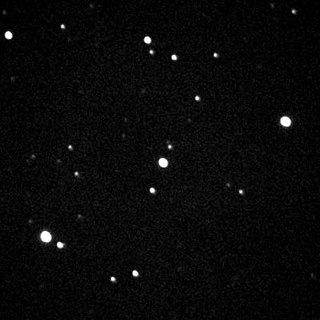
HD 80606 and HD 80607 are two stars comprising a binary star system. They are approximately 217 light-years away in the constellation of Ursa Major. Both stars orbit each other at an average distance of 1,200 astronomical units. The binary system is listed as Struve 1341 in the Struve Catalogue of Double Stars; however, this designation is not in wide use and the system is usually referred to by the HD designations of its constituent stars. An extrasolar planet has been confirmed to orbit HD 80606 in a highly elliptical orbit.

WASP-1 is a metal-rich magnitude 12 star located about 1,250 light-years away in the Andromeda constellation.
HAT-P-4 is a wide binary star consisting of a pair of G-type main-sequence stars in the constellation of Boötes. It is also designated BD+36°2593.
HAT-P-11, also designated GSC 03561-02092 and Kepler-3, is a metal-rich orange dwarf star with a planetary system, 123 light-years away in the constellation Cygnus. This star is notable for its relatively large rate of proper motion. The apparent magnitude of this star is about 9.6, which means it is not visible to the naked eye but can be seen with a medium-sized amateur telescope on a clear dark night. The age of this star is about 6.5 billion years.
GSC 02620-00648 is a double star in the constellation Hercules. The brighter of the pair is a magnitude 12 star located approximately 1,660 light-years away. This star is about 1.18 times as massive as the Sun.

Kepler-4b, initially known as KOI 7.01, is an extrasolar planet first detected as a transit by the Kepler spacecraft. Its radius and mass are similar to that of Neptune; however, due to its proximity to its host star, it is substantially hotter than any planet in the Solar System. The planet's discovery was announced on January 4, 2010, in Washington, D.C., along with four other planets that were initially detected by the Kepler spacecraft and subsequently confirmed by telescopes at the W.M. Keck Observatory.

Kepler-25 is a star in the northern constellation of Lyra. It is slightly larger and more massive than the Sun, with a luminosity 21⁄2 times that of the Sun. With an apparent visual magnitude of 10.6, this star is too faint to be seen with the naked eye.
K2-3, also known as EPIC 201367065, is a red dwarf star with three known planets. It is on the borderline of being a late orange dwarf/K-type star, but because of its temperature, it is classified as a red dwarf.
HIP 41378 is a star located 346 light-years away in the constellation of Cancer. The star has an apparent magnitude of 8.92. This F-type main sequence dwarf has a mass of 1.15 M☉ and a radius of 1.25 R☉. It has a surface temperature of about 6,251 K.

K2-138, also designated EPIC 245950175 or EE-1, is a large early K-type main sequence star with a system of at least 6 planets discovered by citizen scientists. Four were found in the first two days of the Exoplanet Explorers project on Zooniverse in early April 2017, while two more were revealed in further analysis. The system is about 660 light-years away in the constellation Aquarius, within K2 Campaign 12.
K2-19 is an early K-type or late G-type main sequence star that is magnetically active, and has a light curve that exhibits variations in brightness of ~1%. It is located approximately 976 light-years away in the constellation Virgo. Three confirmed transiting exoplanets are known to orbit this star.
K2-58 is a G-type main-sequence star in the constellation of Aquarius, approximately 596 light-years from the Solar System. The star is metal-rich, having 155% of the Solar abundance of elements heavier than helium. The star is located in a region where a hypothetical observer in the K2-58 system can see Venus transiting the sun.
K2-28 is a metal rich M4-type main sequence star. One confirmed transiting exoplanet is known to orbit this star. There is another star 5.2 arcseconds to the north–east of K2-28. However, this star has a different proper motion, and is therefore physically unrelated and probably a background star.

K2-18, also known as EPIC 201912552, is a red dwarf star with two planetary companions located 124 light-years from Earth, in the constellation of Leo.
K2-32 is a G9-type main sequence star slightly smaller and less massive than the sun. Four confirmed transiting exoplanets are known to orbit this star. A study of atmospheric escape from the planet K2-32b caused by high-energy stellar irradiation indicates that the star has always been a very slow rotator.
WASP-55 is a G-type main-sequence star about 980 light-years away. The star is much younger than the Sun at approximately 1.1+0.8
−0.6 billion years. WASP-55 is similar to the Sun in concentration of heavy elements.

K2-296b is a potentially habitable planet discovered by Heller et al. in 2019, orbiting the M-dwarf star EPIC 201238110.

K2-25 is a young red dwarf star located in the Hyades cluster. There is a single known Neptune-sized planet in a 3.5 day orbit.
HAT-P-67 is a binary star system, made up of a F-type subgiant and a red dwarf star, which is located about 1,200 light-years away in the constellation Hercules. There is a hot Saturn planet orbiting the primary star, which is named HAT-P-67b.








